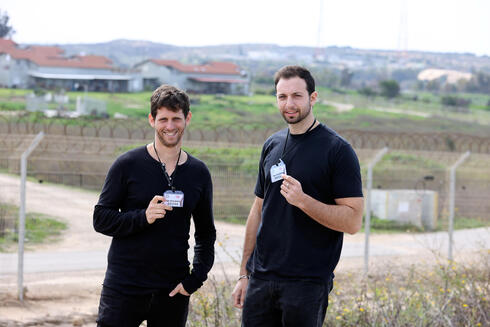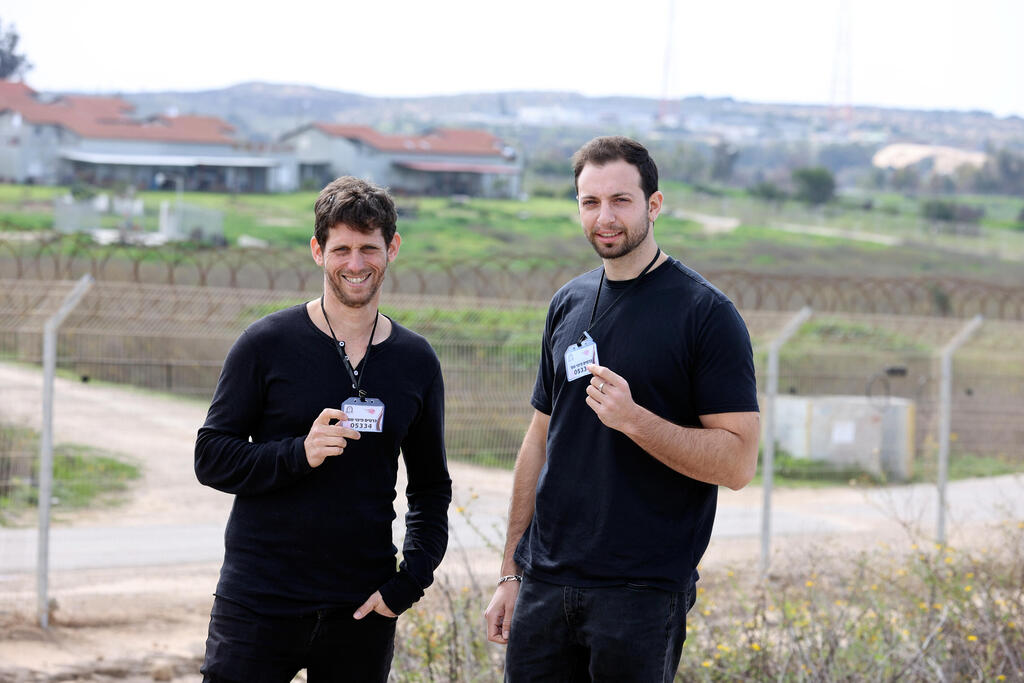
Innovation under fire: Israeli reservists' app is helping save soldiers' lives
Ami Reiss, the keyboardist and music producer of the well-known band Knesiyat HaSechel and Yan Gaitsgory, a strategic consultant, volunteered for the reserves and are behind the development of a unique military application that helps to compile medical data of soldiers wounded in the field to improve their treatment and save lives
Two army reservists, a renowned musician and a strategic advisor, have created a new life-saving application for the army during the Gaza war called Digital 101, a medical evacuation documentation form for injured soldiers in the field. Developed by Ami Reiss, keyboardist and music producer for the well-known band Knesiyat HaSechel, "The Mind Church" in Hebrew, and Yan Gaitsgory, a strategic consultant at an international company, the application records the medical status and journey of those wounded in the field from the point of first treatment in the field until they reach the hospital including details regarding treatment at every point by army medics, search and rescue units, doctors via helicopter, and various hospitals.
"The first goal is to transfer information between points of treatment," explains Gaitsgory. “For example, if a wounded soldier received anesthetic when they were first treated, those treating them at the next stage will know and won't think that they’re unconscious and try CPR or other unnecessary treatments. The second goal is research - collecting all the data and drawing conclusions, such as which defenses work better, which areas are important to protect, and which treatments are important to perform in the field.”
Reiss, 47, and Gaitsgory, 27, previously served in the IDF’s Shaldag and Nahal units respectively, but were not initially called up for reserve duty. Reiss spent the first few days after October 7 driving other reservists around the country in his own vehicle. They were both looking for ways to help and met in a volunteer group to assist the IDF in procuring equipment, through which millions of dollars were raised. Through this connection they were both enlisted as reservists under the Medical Corps to further assist with equipment procurement.
"We had no idea what 101 was," says Reiss. "After a few days of helping bring medical equipment to the country, Lt. Col. Orel Ben-Yishai, the assistant chief medical officer, approached us. He said that the army has been trying to develop a digital 101 form for several years and he wanted us to take it over. This project took off largely thanks to him."
So, what do a musician and a strategic consultant know about developing applications? "I know nothing about technology; I'm a people person. Yan led that aspect," says Reiss. And Gaitsgory says, "Ami maintained contact with the units and teams in the field, and that's one of the reasons this worked. Implementing a technological product in the middle of a war when doctors and medics have so many things to deal with is not simple, and it's largely due to Ami's personal approach and close relationships."
Reiss and Gaitsgory met with the teams in the field and medical corps personnel to learn about their needs and challenges, including Unit 669, the IDF's search and rescue unit, which has been a partner from the beginning in the implementation of the application, as they handle much of the evacuation of wounded soldiers. The two approached KHealth, a company that developed a data-driven digital health platform, and it volunteered to build the application. The budget came from funds raised by the civilian-led organization where Reiss and Gaitsgory first met.
The current application is the fourth version developed during the war, over about two months. As it is prohibited to bring internet-connected devices into Gaza or Lebanon, the application is on a tablet that does not rely on internet access to collect data. In previous versions, data transfer was conducted by connecting a tablet to another tablet, but it didn't work well or fast enough for the evacuation teams. The current version now operating in the field uses an evacuation card to which the data is transferred by connecting it to the tablet.
Another challenge that arose concerns medical confidentiality. "Every wounded person in the field has an evacuation card with a number. There's no identification by name," explains Reiss. "The card connects to the tablet, and the data is transferred. When the soldier arrives at the hospital, they identify him and the number becomes a name.” He adds that the feedback they’ve received from the field has been “amazing.”
This isn't complicated technology, so why hasn't it been developed until now?
"It's not complex technology, especially not in the world of AI, but it was important to emphasize the user experience and make it convenient, fast, and accessible. There were beginnings of such projects in the IDF, but they didn't succeed beyond the pilot stage,” says Gaitsgory.
"It took two crazy people to make it their whole world for a few months," says Reiss. He adds that in addition to KHealth, other collaborators included the Chief Medical Officer (CMO), Brigadier General Prof. Elon Glassberg; Deputy CMO, Lt. Col. Dr. Avi Benov; Lt. Col. Ben-Yishai; and Maj. Dr. M., the commander of Unit 669’s medical unit. “They believed in us, supported us, gave us freedom, vehicles, and weapons, and sent us on a mission."
How is the feedback from the field?
"It's completely operational," says Reiss. "Over 750 wounded soldiers have passed through the system. There are 300 tablets in Gaza and another 300 in the North, and the application was presented to the Chief of Staff. Before the application, the manual form completion rates were very low, between 7-11%, and today it's around 70% - all within two months of implementation."
Gaitsgory says: "It's complicated to fill out a form in the field when you need a pen and a hard surface to write on, and everything is under fire, and the priority is to treat the wounded. We receive online feedback all the time, and sometimes, when the helicopter is en route to the hospital, the medical officer contacts us. The work method was always to receive feedback along the way to improve. It's not all rosy, and initially, there was also negative feedback."
Reiss recounts, "I remember arriving in the field, and two doctors threw the tablet on the floor because in the end its implementing technology in the middle of a war, and not everyone likes technology. But it didn't break us, it just spurred us on. An important moment was when the commander of the medical unit in 669 wrote to me about how the product wasn't working well and that it was a bad idea. Today, he is among those who loves and appreciates the product the most. But when he wrote to me with that initial criticism, that moment could have been either the end of the project or an opportunity to improve it. Most medical teams wanted to help and provide more ideas."
Do you feel it's a life-saving product?
"It's not blood or medicine, but the field doctors say it helps manage treatment better, and provides a clearer picture without someone shouting in your ear and having to remember what was said," says Gaitsgory. "We don't expect anyone to document instead of providing treatment. If there's a choice between evacuating someone or collecting the data, then extract and leave the form, but in many cases, it helps."
"Transferring information from the battlefield is a complex matter," adds Dr. Benov. "A hospital doctor has time to stand in front of the patient and write, which isn't the case in combat situations. We're an army that is always learning, and there wasn’t a solution that we could adopt, like medical equipment, which we could just bring from abroad. In recent years, we tried to crack the product and didn't really succeed because it's very challenging to try to document while being shot at or in the midst of a complex operational situation, and most applications require a network, which we don't have. There are no monitors and devices in the field because we don't want them to be discovered or someone to extract information from them.
"The Digital 101 project existed for years but we couldn't implement it. We wouldn't have succeeded without Ami and Yan's ability to understand the challenge. They went to the field to understand the problems, went to software development, and back for feedback. We're already thinking about the next stage - a wristband or watch that collects, records, and translates data into text, with the ability to photograph an injury. We have a product that works in the field. It's a unique development."
Reiss and Gaitsgory have been in the reserves for four months now, dedicated to the task at all hours. When they talk about the product they have a noticeable spark, and they have many more ideas about how to take the product a few steps further. "For me it was a life-changing project," says Reiss.
Throughout the reserves, Reiss continued to perform with Knesiyat HaSechel for displaced communities, the wounded, and soldiers. He regularly produces large shows including 'Singing in the Square', and says that Digital 101 is “not very different from managing a performance in Caesarea. It's about rallying people and thinking strategically."
"He always has the accordion with him in the car," says Gaitsgory about Reiss. "He’s shy, and when we’d go to the field, I would say that he’s from Knesiyat HaSechel."
“When 669 found out, I said we could play together and that I’d come with the accordion, and we played Knesiyat songs together," Reiss recounts. "Sometimes Yan would come with me to Knesiyat performances for the medical units because it became very special to me."














